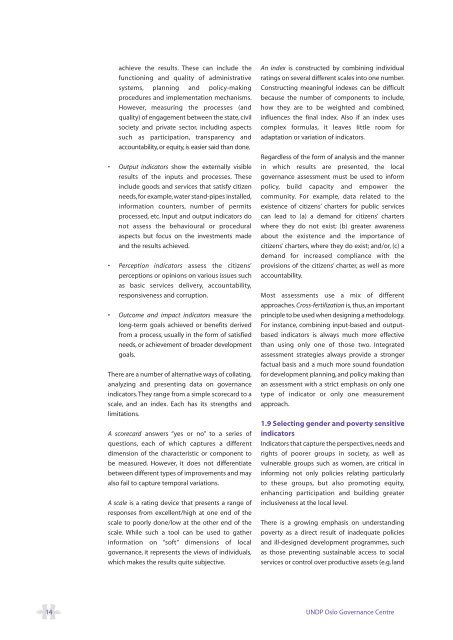A Users' Guide to Measuring Local Governance
A Users' Guide to Measuring Local Governance
A Users' Guide to Measuring Local Governance
Create successful ePaper yourself
Turn your PDF publications into a flip-book with our unique Google optimized e-Paper software.
achieve the results. These can include the<br />
functioning and quality of administrative<br />
systems, planning and policy-making<br />
procedures and implementation mechanisms.<br />
However, measuring the processes (and<br />
quality) of engagement between the state, civil<br />
society and private sec<strong>to</strong>r, including aspects<br />
such as participation, transparency and<br />
accountability, or equity, is easier said than done.<br />
• Output indica<strong>to</strong>rs show the externally visible<br />
results of the inputs and processes. These<br />
include goods and services that satisfy citizen<br />
needs, for example, water stand-pipes installed,<br />
information counters, number of permits<br />
processed, etc. Input and output indica<strong>to</strong>rs do<br />
not assess the behavioural or procedural<br />
aspects but focus on the investments made<br />
and the results achieved.<br />
• Perception indica<strong>to</strong>rs assess the citizens’<br />
perceptions or opinions on various issues such<br />
as basic services delivery, accountability,<br />
responsiveness and corruption.<br />
• Outcome and impact indica<strong>to</strong>rs measure the<br />
long-term goals achieved or benefits derived<br />
from a process, usually in the form of satisfied<br />
needs, or achievement of broader development<br />
goals.<br />
There are a number of alternative ways of collating,<br />
analyzing and presenting data on governance<br />
indica<strong>to</strong>rs.They range from a simple scorecard <strong>to</strong> a<br />
scale, and an index. Each has its strengths and<br />
limitations.<br />
A scorecard answers “yes or no” <strong>to</strong> a series of<br />
questions, each of which captures a different<br />
dimension of the characteristic or component <strong>to</strong><br />
be measured. However, it does not differentiate<br />
between different types of improvements and may<br />
also fail <strong>to</strong> capture temporal variations.<br />
A scale is a rating device that presents a range of<br />
responses from excellent/high at one end of the<br />
scale <strong>to</strong> poorly done/low at the other end of the<br />
scale. While such a <strong>to</strong>ol can be used <strong>to</strong> gather<br />
information on “soft” dimensions of local<br />
governance, it represents the views of individuals,<br />
which makes the results quite subjective.<br />
An index is constructed by combining individual<br />
ratings on several different scales in<strong>to</strong> one number.<br />
Constructing meaningful indexes can be difficult<br />
because the number of components <strong>to</strong> include,<br />
how they are <strong>to</strong> be weighted and combined,<br />
influences the final index. Also if an index uses<br />
complex formulas, it leaves little room for<br />
adaptation or variation of indica<strong>to</strong>rs.<br />
Regardless of the form of analysis and the manner<br />
in which results are presented, the local<br />
governance assessment must be used <strong>to</strong> inform<br />
policy, build capacity and empower the<br />
community. For example, data related <strong>to</strong> the<br />
existence of citizens’ charters for public services<br />
can lead <strong>to</strong> (a) a demand for citizens’ charters<br />
where they do not exist; (b) greater awareness<br />
about the existence and the importance of<br />
citizens’ charters, where they do exist; and/or, (c) a<br />
demand for increased compliance with the<br />
provisions of the citizens’ charter, as well as more<br />
accountability.<br />
Most assessments use a mix of different<br />
approaches. Cross-fertilization is, thus, an important<br />
principle <strong>to</strong> be used when designing a methodology.<br />
For instance, combining input-based and outputbased<br />
indica<strong>to</strong>rs is always much more effective<br />
than using only one of those two. Integrated<br />
assessment strategies always provide a stronger<br />
factual basis and a much more sound foundation<br />
for development planning, and policy making than<br />
an assessment with a strict emphasis on only one<br />
type of indica<strong>to</strong>r or only one measurement<br />
approach.<br />
1.9 Selecting gender and poverty sensitive<br />
indica<strong>to</strong>rs<br />
Indica<strong>to</strong>rs that capture the perspectives, needs and<br />
rights of poorer groups in society, as well as<br />
vulnerable groups such as women, are critical in<br />
informing not only policies relating particularly<br />
<strong>to</strong> these groups, but also promoting equity,<br />
enhancing participation and building greater<br />
inclusiveness at the local level.<br />
There is a growing emphasis on understanding<br />
poverty as a direct result of inadequate policies<br />
and ill-designed development programmes, such<br />
as those preventing sustainable access <strong>to</strong> social<br />
services or control over productive assets (e.g. land<br />
14 UNDP Oslo <strong>Governance</strong> Centre








![GuÃa del Usuario ] - Governance Assessment Portal](https://img.yumpu.com/44740603/1/190x253/gua-a-del-usuario-governance-assessment-portal.jpg?quality=85)







